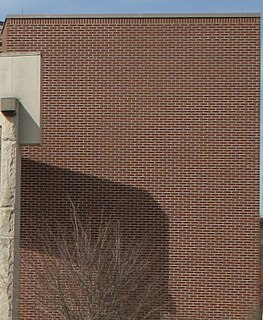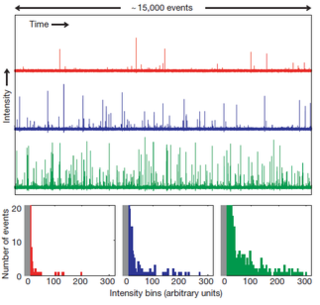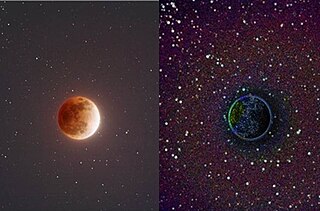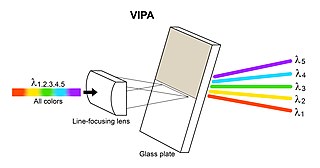
In electronics, an analog-to-digital converter is a system that converts an analog signal, such as a sound picked up by a microphone or light entering a digital camera, into a digital signal. An ADC may also provide an isolated measurement such as an electronic device that converts an input analog voltage or current to a digital number representing the magnitude of the voltage or current. Typically the digital output is a two's complement binary number that is proportional to the input, but there are other possibilities.
A chirp is a signal in which the frequency increases (up-chirp) or decreases (down-chirp) with time. In some sources, the term chirp is used interchangeably with sweep signal. It is commonly used in sonar, radar, and laser, but has other applications, such as in spread-spectrum communications.

In electronics, a digital-to-analog converter is a system that converts a digital signal into an analog signal. An analog-to-digital converter (ADC) performs the reverse function.

In signal processing and related disciplines, aliasing is an effect that causes different signals to become indistinguishable when sampled. It also often refers to the distortion or artifact that results when a signal reconstructed from samples is different from the original continuous signal.

In optics, dispersion is the phenomenon in which the phase velocity of a wave depends on its frequency. Media having this common property may be termed dispersive media. Sometimes the term chromatic dispersion is used for specificity. Although the term is used in the field of optics to describe light and other electromagnetic waves, dispersion in the same sense can apply to any sort of wave motion such as acoustic dispersion in the case of sound and seismic waves, in gravity waves, and for telecommunication signals along transmission lines or optical fiber.

Photonics is the physical science of light (photon) generation, detection, and manipulation through emission, transmission, modulation, signal processing, switching, amplification, and sensing. Though covering all light's technical applications over the whole spectrum, most photonic applications are in the range of visible and near-infrared light. The term photonics developed as an outgrowth of the first practical semiconductor light emitters invented in the early 1960s and optical fibers developed in the 1970s.

In signal processing, sampling is the reduction of a continuous-time signal to a discrete-time signal. A common example is the conversion of a sound wave to a sequence of samples.
In optics, an ultrashort pulse of light is an electromagnetic pulse whose time duration is of the order of a picosecond or less. Such pulses have a broadband optical spectrum, and can be created by mode-locked oscillators. They are commonly referred to as ultrafast events. Amplification of ultrashort pulses almost always requires the technique of chirped pulse amplification, in order to avoid damage to the gain medium of the amplifier.
In a mixed-signal system, a reconstruction filter, sometimes called an anti-imaging filter, is used to construct a smooth analog signal from a digital input, as in the case of a digital to analog converter (DAC) or other sampled data output device.
Optical resolution describes the ability of an imaging system to resolve detail in the object that is being imaged.
Slow light is the propagation of an optical pulse or other modulation of an optical carrier at a very low group velocity. Slow light occurs when a propagating pulse is substantially slowed down by the interaction with the medium in which the propagation takes place.
Multiphoton intrapulse interference phase scan (MIIPS) is a method used in ultrashort laser technology that simultaneously measures, and compensates femtosecond laser pulses using an adaptive pulse shaper. When an ultrashort laser pulse reaches a duration of less than a few hundred femtosecond, it becomes critical to characterize its duration, its temporal intensity curve, or its electric field as a function of time. Classical photodetectors measuring the intensity of light are still too slow to allow for a direct measurement, even with the fastest photodiodes or streak cameras.
Serial time-encoded amplified imaging/microscopy or stretched time-encoded amplified imaging/microscopy' (STEAM) is a fast real-time optical imaging method that provides MHz frame rate, ~100 ps shutter speed, and ~30 dB optical image gain. Based on the Photonic Time Stretch technique, STEAM holds world records for shutter speed and frame rate in continuous real-time imaging. STEAM employs the Photonic Time Stretch with internal Raman amplification to realize optical image amplification to circumvent the fundamental trade-off between sensitivity and speed that affects virtually all optical imaging and sensing systems. This method uses a single-pixel photodetector, eliminating the need for the detector array and readout time limitations. Avoiding this problem and featuring the optical image amplification for dramatic improvement in sensitivity at high image acquisition rates, STEAM's shutter speed is at least 1000 times faster than the state-of-the-art CCD and CMOS cameras. Its frame rate is 1000 times faster than fastest CCD cameras and 10-100 times faster than fastest CMOS cameras.
Time stretch dispersive Fourier transform (TS-DFT), otherwise known as time-stretch transform (TST), temporal Fourier transform or photonic time-stretch (PTS) is a spectroscopy technique that uses optical dispersion instead of a grating or prism to separate the light wavelengths and analyze the optical spectrum in real-time. It employs group-velocity dispersion (GVD) to transform the spectrum of a broadband optical pulse into a time stretched temporal waveform. It is used to perform Fourier transformation on an optical signal on a single shot basis and at high frame rates for real-time analysis of fast dynamic processes. It replaces a diffraction grating and detector array with a dispersive fiber and single-pixel detector, enabling ultrafast real-time spectroscopy and imaging. Its nonuniform variant, warped-stretch transform, realized with nonlinear group delay, offers variable-rate spectral domain sampling, as well as the ability to engineer the time-bandwidth product of the signal's envelope to match that of the data acquisition systems acting as an information gearbox.
An anamorphic stretch transform (AST) also referred to as warped stretch transform is a physics-inspired signal transform that emerged from time stretch dispersive Fourier transform. The transform can be applied to analog temporal signals such as communication signals, or to digital spatial data such as images. The transform reshapes the data in such a way that its output has properties conducive for data compression and analytics. The reshaping consists of warped stretching in the Fourier domain. The name "Anamorphic" is used because of the metaphoric analogy between the warped stretch operation and warping of images in anamorphosis and surrealist artworks.

Optical rogue waves are rare pulses of light analogous to rogue or freak ocean waves. The term optical rogue waves was coined to describe rare pulses of broadband light arising during the process of supercontinuum generation—a noise-sensitive nonlinear process in which extremely broadband radiation is generated from a narrowband input waveform—in nonlinear optical fiber. In this context, optical rogue waves are characterized by an anomalous surplus in energy at particular wavelengths and/or an unexpected peak power. These anomalous events have been shown to follow heavy-tailed statistics, also known as L-shaped statistics, fat-tailed statistics, or extreme-value statistics. These probability distributions are characterized by long tails: large outliers occur rarely, yet much more frequently than expected from Gaussian statistics and intuition. Such distributions also describe the probabilities of freak ocean waves and various phenomena in both the man-made and natural worlds. Despite their infrequency, rare events wield significant influence in many systems. Aside from the statistical similarities, light waves traveling in optical fibers are known to obey the similar mathematics as water waves traveling in the open ocean, supporting the analogy between oceanic rogue waves and their optical counterparts. More generally, research has exposed a number of different analogies between extreme events in optics and hydrodynamic systems. A key practical difference is that most optical experiments can be done with a table-top apparatus, offer a high degree of experimental control, and allow data to be acquired extremely rapidly. Consequently, optical rogue waves are attractive for experimental and theoretical research and have become a highly studied phenomenon. The particulars of the analogy between extreme waves in optics and hydrodynamics may vary depending on the context, but the existence of rare events and extreme statistics in wave-related phenomena are common ground.

Phase stretch transform (PST) is a computational approach to signal and image processing. One of its utilities is for feature detection and classification. PST is related to time stretch dispersive Fourier transform. It transforms the image by emulating propagation through a diffractive medium with engineered 3D dispersive property. The operation relies on symmetry of the dispersion profile and can be understood in terms of dispersive eigenfunctions or stretch modes. PST performs similar functionality as phase-contrast microscopy, but on digital images. PST can be applied to digital images and temporal data.
Photonic radar is a technique by which radar may be produced and analysed with the help of photonics rather than traditional RF techniques. The frequency of the radar is still in the RF, but lasers are used to create and analyse the RF signals with high precision. The name "photonic radar" is sometimes used to mean visible-spectrum range finding like Lidar.

A virtually imaged phased array (VIPA) is an angular dispersive device that, like a prism or a diffraction grating, splits light into its spectral components. It works almost independently of polarization. In contrast to prisms or regular diffraction gratings, it has a much higher angular dispersion but has a smaller free spectral range. This aspect is similar to that of an Echelle grating which is usually used in reflection, since high diffraction orders are also used there. The VIPA can be a compact optical component with high wavelength resolving power.
Andrew Marc Weiner is an American electrical engineer, educator and researcher known for contributions to the fields of ultrafast optics and optical signal processing. He is the Scifres Family Distinguished Professor of Electrical and Computer Engineering at Purdue University.











